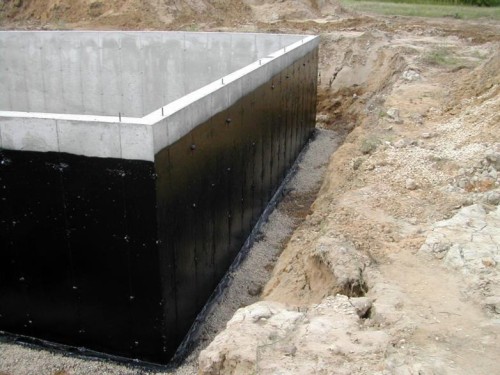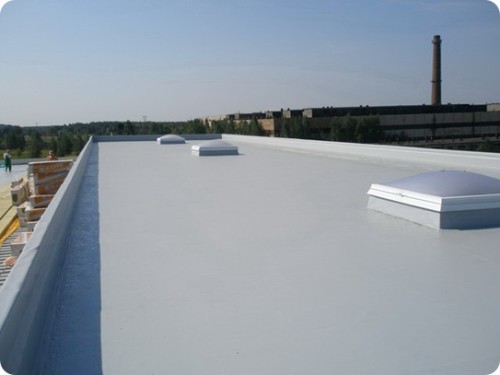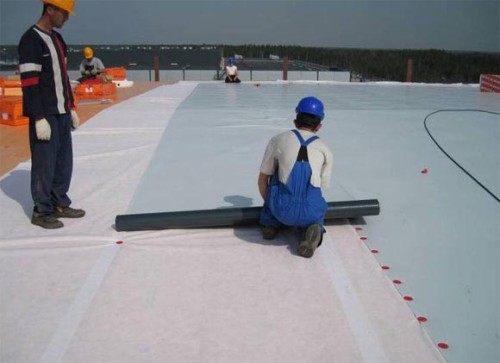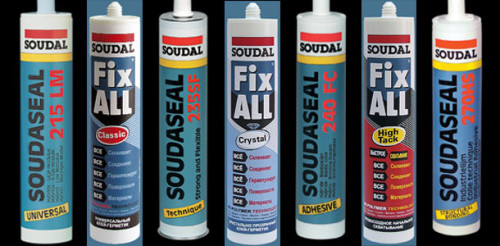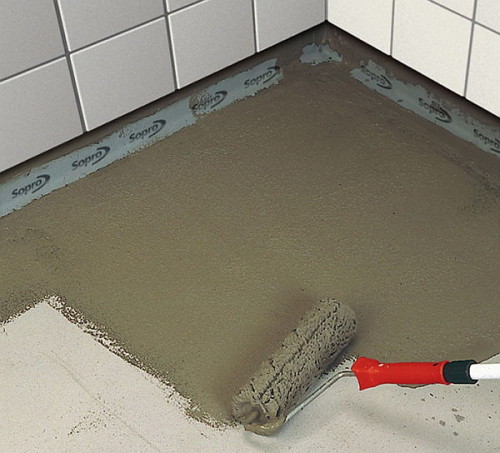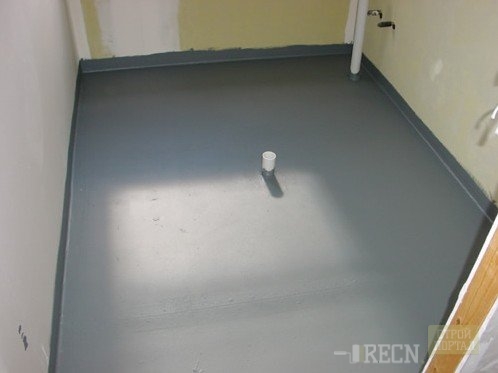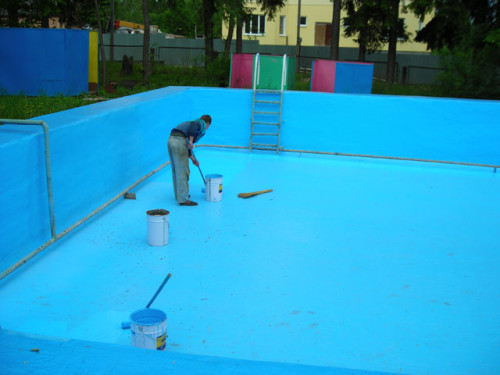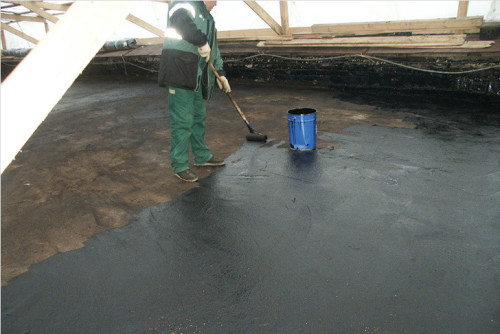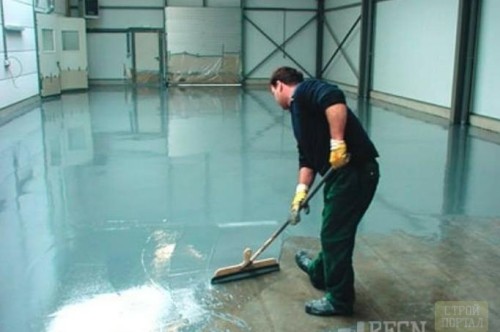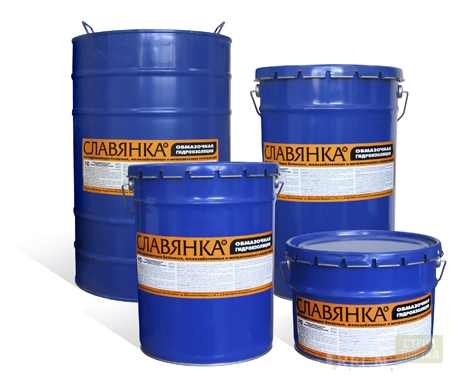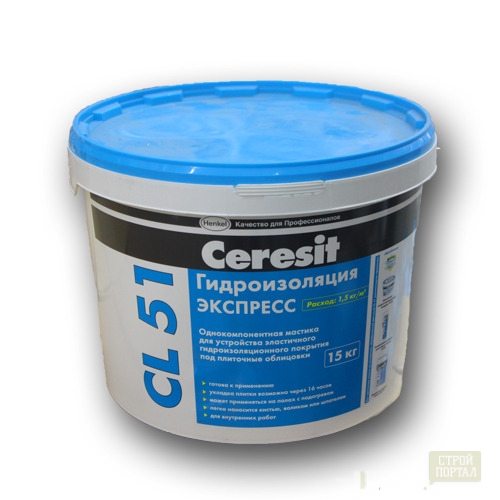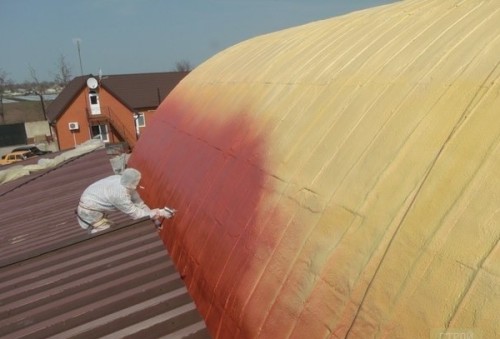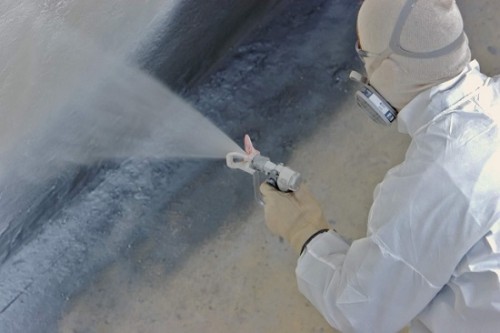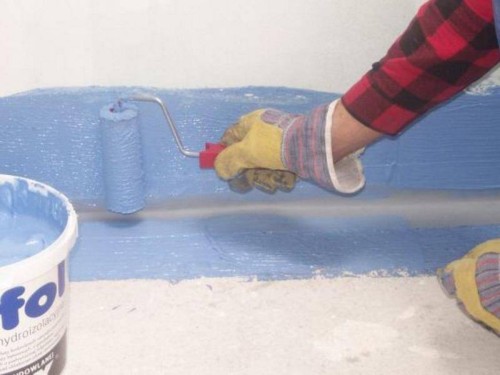
Polymer Waterproofing: Selection of Material and Application Features Insulation
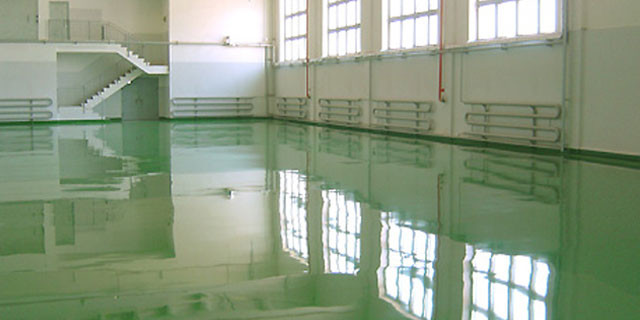
Without high-quality waterproofing, it is impossible to build a reliable building or arrange a high-quality interior. The modern market offers many different solutions to such a task. One of the most popular - polymer waterproofing. You will learn about all the types of advantages and ways to use this article.
Content
What is polymer waterproofing?
Waterproofing on a polymer basis is a predominantly bituminous emulsion that is combined with latex particles. The range of compositions of such a material is quite diverse. Depending on the manufacturer and destination, solutions may include:
- polyurethane;
- mineral fragments;
- cement;
- acrylic;
- epoxy resins;
- rubber crumb;
- polystyrene.
Important! The effect of air of a certain temperature contributes to the polymerization of the solution. As a result, a durable, but damaging membrane, properties and specifications of which are fully consistent with the modern requirements of construction are formed.
The advantages of liquid waterproofing roofing
Waterproofing with polymeric materials gives many advantages. With the right choice of solution and its application, a canvas with very high moisture-repellent properties are formed. In addition, the undoubted advantages of polymer waterproofing is:
- the maximum possible elasticity - up to 400% of stretching;
- durability - the service life of such a coating is under warranty from 25, in practice - from 50 years;
- the formation of a monolithic coating without seams, which eliminates the possibility of leaking water after a long time;
- a wide range of applications - used for any designs, even with a complex or non-standard configuration and a plurality of small embossed elements;
- absolute resistance to any aggressive exposure - mechanical, chemical, ultraviolet, temperature (-60c - + 110c);
- the optimal wear resistance - a layer of polymer waterproofing does not fill, remains even and durable under any conditions, regardless of the duration of operation;
- economical consumption and minor coating thickness, which allows you to immediately calculate the budget for construction and not make additional steps to enhance the construction;
- excellent adhesion with materials of any type - concrete, block modules, metal, wood, all types of decorative finishing coatings;
- simplicity of application and the ability to choose technology directly under a certain project and level of professional skills;
- the minimum deadlines of the rejection - affects the total construction time;
- safe and harmless material with the absence of toxic impurities and poisonous evaporation;
- maintainability - after long-term operation, in the formation of any defects, the coating is easily restored by applying over the existing additional layer over the entire area or locally, on problem places;
- parry permeability, which is very important for some types of building materials and for a comfortable microclimate indoor;
- a wide range of colors - allows the use of polymer waterproofing and as a finishing decorative material.
Important! The only disadvantage of polymer waterproofing can be noted its price - it is somewhat higher than the usual runner and bitumen. But the quality of the result obtained is fully justified by such a cost. Evaluate all the advantages of such a decision and its profitability can be based on the obvious savings of additional costs for repair and replace waterproofing, as well as materials that it protects for a long time.
Types of polymer waterproofing
All solutions of polymer waterproofing can be divided into several types, pushing out such criteria:
- consistency;
- appointment;
- component composition;
- mode of application.
Consistency of solution
This feature distinguish:
- liquid solutions;
- semi-liquid.
Important! There are still rolled membranes, which also find their use, but are less demand.
Purpose of waterproofing
Modern manufacturers are developing wide model ranges of their own products, with recommendations for use for specific structural elements of buildings, for example:
- polymer waterproofing for roofing;
- polymer waterproofing for floors;
- for foundation;
- for metal structures.
If you take more common positions, allocate such options:
- polymer mastic for waterproofing - used directly to process large areas, is distinguished by greater fluidity of the solution;
- sealant - used exclusively for sealing cracks, seams, joints, the solution is allocated greater viscosity.
Component composition
Depending on the combination and type of elements used, many types of solutions are distinguished. Waterproofing is most popular today:
- cement-polymer;
- bituminous polymer.
Method of application
The method of applying for a specific project is often determined by the experience of the master, the presence or absence of tools and equipment, disposed of deadlines for the completion of the waterproofing stage and other factors. This feature distinguish:
- coating polymer waterproofing;
- liquid;
- solutions of their own preparation, for example, based on epoxy resin.
Important! The last type of mixtures involves mixing certain components according to the recipe manufacturer. The second important nuance is a clear observance of application periods, otherwise the finished solution is hardening directly in the tank and becomes unsuitable. This option can do somewhat cheaper if there is a qualified specialist with rich professional experience, which has all the necessary equipment at hand. For private construction, the solutions are most often acquired.
The use of polymer waterproofing
Waterproofing with polymeric materials absolutely does not limit the possibilities. It is used everywhere for different purposes:
- terrestrial and underground facilities;
- hydraulic installations;
- wet premises.
If this list is detailed, the elastic polymer waterproofing is used to protect:
- roofing;
- floors, walls, ceilings in the bathrooms;
- foundations;
- cleaning structures;
- wells, pools, gateways, dams, channels;
- basements;
- garages;
- park;
- bridges;
- engineering communications;
- facades of buildings.
Important! On this list, only the most popular solutions are noted, but the listed options are far from the full range of polymer waterproofing.
Methods for applying polymer waterproofing
Depending on the experience, the availability of technical equipment, budget opportunities and other features of your construction, select the best way to finish the building or room:
- staining - In this case, you will need paint brushes and rollers;
- spraying - performed by airless pumping.
Important! The first method is advisable to use for waterproofing small areas, the second - for spacious premises or overall designs. Another condition is the presence of special equipment and skills in its application.
As mentioned above, there is also a rolled polymer membrane, the installation of which implies rolling on the desired surface with the lanes and the brewing of the seams.
Polymer waterproofing - technology
You can not buy any material and simply treat them the desired surface. As with other methods of waterproofing, work is performed in several steps:
- Choose a suitable solution.
- Make the correct count of the desired amount.
- Prepare the design surface to finish.
- Treat all elements of the room, buildings, structures with mortar, compliance with the recommendations of professionals and the manufacturer.
- Hold the technical pause to complete rejection.
- Ensure a qualitative result.
Selection of material
When choosing elastic polymer waterproofing, focus not only on the scope of work and the features of your design. The result will be largely dependent on the reliability and conscientiousness of the manufacturer. Since a good moisture-repellent layer is a guarantee of your comfort and maintaining the strength of all building materials, give preference to those brands that have no doubt about consumers for many years:
- Slav;
- Liquid Rubber;
- Tehnonikol;
- Rapidflex;
- Rauflex;
- Ultramaster;
- Ceresit;
- Soudal.
Polymer waterproofing consumption
The solution consumption will depend on many factors, but the average can be determined independently - each manufacturer on the package indicates a specific number.
According to standards:
- epoxy formulations are used on average in the range of 0.65-1 kg per 1 m2;
- bituminous polymer and cement-polymer - 1 kg per 1-2 m2.
Important! The data is shown for 1 layer with a thickness of 2 mm, respectively, from the intended number of layers and the increase in thickness increases in proportion to the amount of solution of polymer waterproofing. Do not forget also the unlawful rule of application of any material - 10% of the overrun.
Preparatory stage
The quality of adhesion is largely dependent on the quality of the preparatory work, which means the strength, evenness of the moisture-repellent layer.
The whole process does not take much time, if you act clearly and consistently:
- Check the surface evenness.
- Note the presence of explicit defects.
- Eliminate all really important shortcomings.
- Collect all the construction garbage and dust.
- Make wet cleaning.
- Wait for the surface drying.
Spraying waterproofing
If you decide to quickly perform all the work and apply special equipment, in this way:
- Prepare pump airless installation.
- Check if it is fully equipped.
- Prepare a solution of calcium chloride or immediately fill it into the container if bought ready.
- Attach this container to the applied unit.
- Connect the container with waterproofing solution to equipment.
- Spray the mixture to the surface you need.
- Check that simultaneous digging of two tanks are performed.
- Move the direction of the jet so that as a result you have a uniform layer with a thickness of 2 to 4 mm (depends on the type of design).
Important! If you are ready to buy or rent such equipment, but you cannot decide on the right model, take on the note those aggregates, efficiency and ease of use of which have already noted many consumers:
Foolish waterproofing on a polymeric basis
Cheaper, but labor-intensive way. At the same time, using such technology, you can make high-quality waterproofing of a small room or a separate surface, without allowing the interpretation of the mixture.
Progress:
- Buy and prepare the tool you need - Depending on the type of design, a wide brush is suitable or a rairy roller with a short pile.
- Savit a dysple part of the device into the solution.
- Scroll through all the surface you need, withsting the layer thickness from 2 to 4 mm.
- Make a small technical pause.
- Apply the following layer.
Important! If the smooth and smoothness of the coating is very important, check the quality of the work performed on the construction level. Correct all detected defects.
Polymer Waterproofing - Video
The decoration of some surfaces, for example, ceilings, is often the most inconvenience due to the location. Review the video in which it is clearly shown an example of how easy and quickly can cope with the waterproofing of complex places with polymer solutions.
Conclusion
Now you know what polymer waterproofing is what it happens and how can it be used. Consider all the manufacturer's recommendations, listen to the opinions of professionals, clearly, carefully and not in a hurry. Perform all the work related to the waterproofing of your home. In this case, you do not have to doubt its reliability and strength over long years. And this is the key to a convenient and pleasant stay in it.




